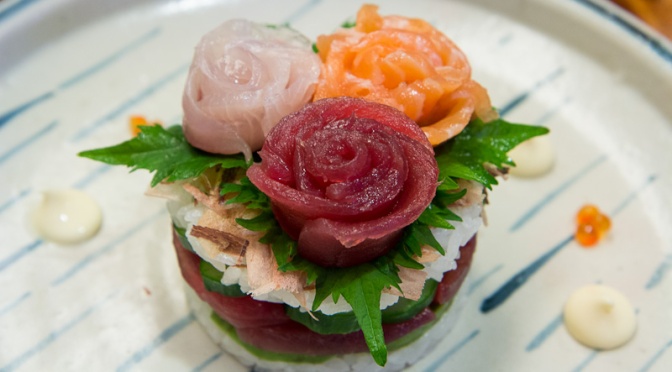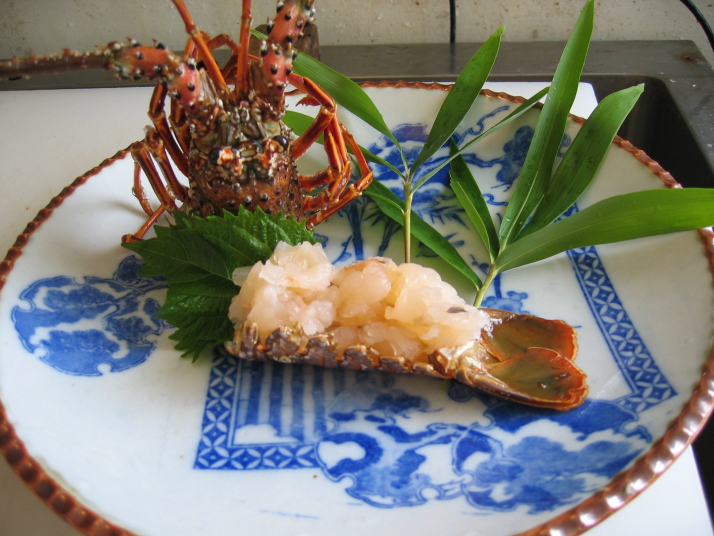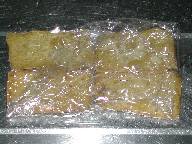French version down

Takuan (沢庵), also known as takuwan or takuan-zuke, is a popular traditional Japanese pickle. It is made from daikon radish. In addition to being served alongside other types of tsukemono/Japanese-style pickles in traditional Japanese cuisine, takuan is also enjoyed at the end of meals as it is thought to aid digestion.
Takuan is made by first hanging a daikon radish in the sun for a few weeks until it becomes flexible. Next, the daikon is placed in a pickling crock and covered with a mix of salt, rice bran, optionally sugar, daikon greens, kombu/Dry seaweed, and perhaps chilli pepper and/or dried persimmon peels/even flowers for colouring. A weight is then placed on top of the crock, and the daikon is allowed to pickle for several months. The finished takuan is usually yellow in colour, although most mass-produced takuan rely on food coloring for this effect.
Takuan is popular also in South Korea, and is called danmuji (단무지). It is used as a filling for gimbap, or as an accompaniment to Korean dishes, typically jajangmyeon.
Here is a simple basic recipe to make when you get hold of plenty cheap daikon. Since it is vegan in nature, it shoild please everyone!
Check the extra recipe for ideas!
INGREDIENTS: Bear in mind that the bigger the batch, the better!
-Daikon: 10~15 with their leaves!
-Rice bran: 15 % of the dried daikon weight
-Salt: 6% of the dried daikon weight
-Brown Sugar: half a tablespoon
-Chili pepper: half one, chopped, fresh
-Konbu/dry seaweed: 3~5 cm piece chopped thin
-Fruit peel (persimmon, orange according to colour): 2 fruits
-White sugar: 1 tablespoon per daikon
FIRST RECIPE:

Wash the daikon with their leaves. It is important to dry them with their leaves as to prevent a loos in quality. Place them to dry in a spot well exposed to the sun and wind. Let them dry for 1~2 weeks. Bring them inside at night if you think morning dew will come on them!
They will be ready the moment they bend easily.

-Wipe daikon with a clean towel.
Weight the daikon then and prepare rice bran (15% of daikon weight) and salt (6% of daikon weight).

-Cut the leaves with the end of the daikon. Cut enough of the daikon so that the leaves hold together. Put leaves aside. You will use them later!
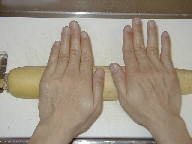
-Put each daikon (work on one at a time) on a working table. Roll it by solidly pressing your palms on the daikon all along its length to soften evental hard spots and even the humidity inside.

-In a separate bowl pour in the rice bran, salt, brown sugar, chopped konbu/seaweed, chopped chili pepper and white sugar. Mix well.
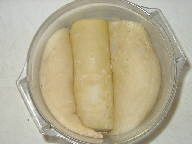
-Use a large pickles jar/bucket.
First line the bottom with some of the pickle mixture.
Line a first layer of daikon, leaving as little sapce between as possible.
Sprinkle with pickle mixture.
Fill any space left with the daikon leaves.
Repeat same procedure with the rest of the daikon.

-Line the top with the remaining daikon leaves.
Press down with your hands, putting all your weight behind your hands.
Sprinkle some extra salt over the top to prevent mold from forming.

You can use a special pickle vat as in picture above and screw down the lid for maximum pressure.
If you uve a normal vat, plce a clean wooden or plastic circle on top of the daikon and lay a weight/stone at least 3 times the weight of the daikon.
In the latter case cover with newspaper and a lid to prevent any dust insid.e

-Pickle for 4 weeks in winter, or 3 weeks in summer.
Clean them quickly in clean cold running water before cutting and serving them!
SECOND RECIPE: Traditional but the process is the same!

INGREDIENTS:
-1) Dried daikon: 12 kg
-2) Rice bran: 1.5 kg
-3) Salt: 720 g
-4) Kaki/Persimmon (frozen): 5~6
-Chili peppers: 10 (cut in halves9
-Konbu/seaweed: 40 cm (to be chopped)
Look at the pictures, the process is the same!

Drying

Soft enough to bend

Cutting the leaves away
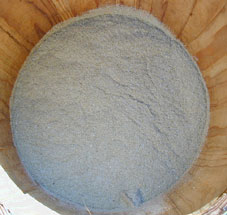
Pickle mixture

Pickle mixture added with kobu, chili peppers and persimmons

Fitting the daikon in tightly

Covering with the pickle mixture
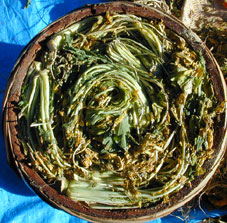
Covering with the leaves

Putting the weights on top!
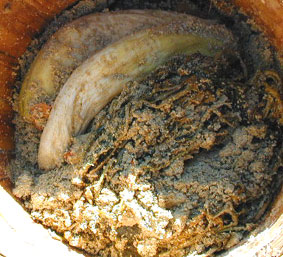
Two months later.

Washed, cut and served!

Le Takuan (沢庵), aussi appelé takuwan ou takuan-zuke est un pickle traditionnel japonais courant ! Il est fait à partir de radis japonais daikon et est servi avec d’autres légumes vinaigrés dans les plats traditionnels japonais. On peut aussi le consomme en fin de repas étant donné qu’il est réputé pour favoriser la digestion !
Tout d’abord il vous faudra suspendre le radis au soleil pendant quelques semaines pour qu’il soit plus maléable, ensuite il faudra le placé dans un pot de fermentation recouvert d’un mélange de sel, de son de riz, et à votre goût du sucre, d’algue kombu ou autre algue séchée ou du piment, de la peau de kaki et même des fleurs qui donneront de la couleur à votre ouvrage ! La plupart des takuan utilisent la couleur comme argument de vente !
On trouve le Takuan en Corée du Sud sous le nom de danmuji (단무지) souvent utilisé comme garniture pour le gimbap ou en accompagnement d’autres plats tels que le jajangmyeon.
Voici une recette simple et utile si vous mettez la main sur plein de daikon, ou alors les obtenez à bon prix !. Une recette végétarienne qui devrait vous donner des idées.
INGREDIENTS: Gardez à l’esprit que plus c’est gros, mieux c’est !
-Daikon: 10~15 avec leurs feuilles!
-Son de riz: 15 % du poids des daikon
-Sel: 6% du poids des daikon secs
-Sucre brun: la moitié d’une cuillère à soupe
-Piment: Une demi piment frais et haché
-Konbu/algue sèche: 3~5 cm haché finement
-Peua de fruits : (selon la couleur que vous voudrez, kaki ou orange): 2 fruits
-Sucre blanc: 1 cuillère à soupe par légume
Première recette :

Lavez le daikon avec ses feuilles. Il est important qu’ils soient séchés avec le feuilles pour ne pas qu’ils perdent en qualité. Mettez-les dans un un endroit sec et bien exposé au soleil et au vent. Laissez les sécher pendant une ou deux semaines. Ramnez les dans l’intérieur de la maison pendant la nuit si vous pensez que la rosée va les endommager ! Ils seront considérés comme prêts une fois que vous pourrez les plier facilement.

Essuyez-les avec un linge propre et pesez-le pour faire en sorte que le son de riz en pèse 15 pour cent et 6 pour cent de sel.

Coupez les feuilles à l’extrémitié du daikon. Coupez-le assez pour que les feuilles restent liées entre elles et gardez-les de côté pour une utilisation ultérieure.

Mettez chaque daikon (maniez-en un seul à la fois) sur un plan de travail. Roulez-le fermement avec vos paumes et sur toute sa longueur pour ramollir les nœuds un peu trop durs et en retirer l’humidité.

Dans un récipient séparé, mettez le son de riz, le sucre brun, les algues hachées finement, les piments et le sucre blanc. Mélangez bien.

Prenez ensuite un gros récipient, et au premier étage mettez vos pickles en faisant en sorte que ce premier étage ait peut d’espace entre ses pickles. Saupoudrez-le avec la mixture et remplissez les espaces avec les feuilles. Refaire cette procédure avec tous les daikons que vous avez sous la main.

Couvrez le dessus avec le reste de vos feuilles de daiko, et appuyez de tout votre poids. Saupoudrez de sel pour éviter la moisissure.

Vous pouvez utiliser un accessoir pour pickles comme celui ci-dessus pour un maximum de pression, il suffira de placer un bout de bois propre ou de plastique au dessus des daikons ainsi qu’une pierre d’environs trois fois le poids des radis japonais ! Dans ce cas il faudra couvrir avec des journaux pour bloquer l’entrée de particules étrangères.

-Pickle for 4 weeks in winter, or 3 weeks in summer.
Clean them quickly in clean cold running water before cutting and serving them!
Laissez fermenter tout ce beau monde 4 semaines en hiver et 3 en été. Nettoyez les ensuite rapidement avec de l’eau froide avant de les couper et les servir.
Deuxième recette: La méthode à l’ancienne, mais qui suit un peu le même processus !

INGREDIENTS:
-Son de riz: 1,5 kg
-Sel: 720grammes
Piment: Une dizaine coupés en moitié
-Konbu/algue sèche: 40 cm à hacher
– Kaki (congelés) : 5 ou

Séchage

On vérifie la flexibilité !

On coupe les feuilles !

La mixture à pickles!

Avec les algues, les kakis et les piments.

On serre les daikons !

On couvre le tout avec la mixture !

Puis les feuilles !

On met un peu de poids là dessus.

Et voici après deux mois.

Le festin après lavage !
RECOMMENDED RELATED SITES:
Bread + Butter, Comestilblog, Greedy Girl, Bouchon For 2, Zoy Zhang, Hungry Neko, Mangantayon, Elinluv Tidbit Corner, Maison de Christina, Chrys Niles, Lexi, Culinary Musings, Eats and Everything, Bite Me New England, Heather Sweet, Warren Bobrow, 5 Star Foodie, Frank Fariello, Oyster Culture, Ramendo, Alchemist Chef, Ochikeron, Mrs. Lavendula, The Gipsy Chef, Spirited Miu Flavor, Wheeling Gourmet, Chef de Plunge, Sushi Nomads, Island Vittles, The French Market Maven, Tokyo Through The Drinking Glas, Palate To Pen, Tokyo Foodcast, Good Beer & Country Boys, Tokyo Terrace, Think Twice, Jefferson’s Table, While mY Sautoir Gently Weeps
Please check the new postings at:
sake, shochu and sushi,
—————————————-
日本語のブログ
—————————————-


